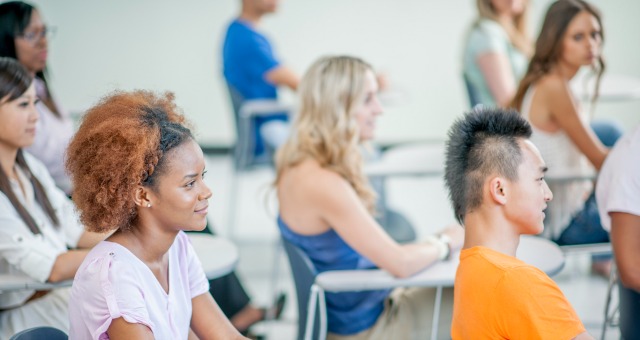There are empty chairs in classrooms in Florida this week, at Valencia College, University of Central Florida, and Ana G. Mendez University, spaces left by the youngest victims of the Pulse nightclub shootings in Orlando. Most of them young gay men, most of them Latino. In the academic world, June is a time of celebration, of convocation, of inspired addresses to graduates ready to take their hard-earned degrees and all that they have learned into the real world. In the LGBTQ communities, June is Pride month, a time to celebrate hard-earned rights, to look back on how far we have come, and how far we still have to go. This year, it is a time to mourn, and as we gather to stand in solidarity, there is that old, familiar feeling of looking over our shoulders for the next threat.
In the face of violence and hatred, it’s a natural reaction to seek safety. In the last two decades, there has been an abundance of dialogue about creating “safe” classroom spaces. Safe spaces have been defined as an “environment in which students are willing and able to participate and honestly struggle with challenging issues” (Holley and Steiner, 2005). Creating learning environments that are inclusive and respectful of all members is a fundamental principle of liberal education.
But perhaps this is a pivotal moment to accept that safety is an illusion. At the recent Teaching Professor Conference in Washington, D.C., I attended a session titled, “Inspiring Empathy: Teaching about Human Diversity in the Classroom.” Katherine Morrison from Curry College encouraged participants to reflect on the challenges they experience in facilitating discussions on issues of diversity. I shared my worries about exchanges that become polarized when students stop listening to one another, but a colleague from a few rows back expressed a more immediate concern. She feared the possibility of students coming to class armed with a concealed weapon.
In the presence of threat, real or perceived, how safe can our classrooms be? My colleague, Sherry Zane from the University of Connecticut, suggests that perhaps what we need to strive for are “brave” spaces and courageous conversations (Arao & Clemens, 2013). “Brave” classrooms are places where students and faculty openly share their different perspectives and life experiences for the purpose of learning, fully aware that there is risk involved in doing so. And learning does not take place when our firmly held beliefs are never challenged. It is the hallmark of a robust education that students graduate having been exposed to new ideas, differing perspectives, and challenging ways of thinking. This process can and should be difficult, messy, and certainly uncomfortable. In academic terms, it is when we are at the edge of discomfort that learning truly happens.
“When we find ourselves at the limit of our comfort zones, we are in the best place to expand our understandings, take in different perspectives, and broaden our awareness.” (Adams, Bell and Griffin, 2007)
Admittedly, finding this critical edge for learning is a delicate balancing act that can challenge the skills of even the most gifted facilitators of discussion. But what is the alternative? Our college-aged students have been raised in an environment where political discourse has been reduced to slinging insults, and in the absence of true debate, positions simply become more firmly entrenched. In this context, we need to find a way to help our learners learn from, with, and about each other. And we need to help them bear the discomfort of listening, listening carefully, to others whose lived experiences and opinions are different than their own. In order to face the complex challenges of the world they are graduating into, our students will need to work together. And in order to do so, effectively, we need to help them learn how this is done.
As we mourn the loss of those who died in Orlando, and reel at the power of hate, perhaps we can rededicate our energy into creating brave spaces for learning. Let’s create spaces where our LGBTQ students can find their identities acknowledged and celebrated, not just tolerated, where our black and Latinx students have their histories told and are affirmed that their lives matter, where our Muslim students are not labelled terrorists, and where our immigrant and undocumented students are welcomed and given the right to an education, regardless of birthplace.
In the face of hate, it’s easy to become paralyzed, but the only way to fight hate is to do something. “In the face of hatred, apathy will be interpreted as acceptance — by the perpetrators, the public and, worse, the victims. Decent people must take action; if we don’t, hate persists.” (Ten Ways to Fight Hate: A Community Response Guide) As educators, let’s do that something in our classrooms and let’s do it now.
References
Adams, M., Bell, L.A. & Griffin, P. (2007) Teaching for Diversity and Social Justice. Routledge, New York.
Arao, B & Clemens, K. (2013) From Safe Spaces to Brave Spaces: A New Way to Frame Dialogue Around Diversity and Social Justice in The Art of Effective Facilitation. Landerman, Lisa (ed). Stylus Publishing. Retrieved from http://ssw.umich.edu/sites/default/files/documents/events/colc/from-safe-spaces-to-brave-spaces.pdf
Holley, L.C., & Steiner, S. (2005). Safe Space: Student perspectives on classroom environment. Journal of Social Work Education, 41 (1), 49-64.
Southern Poverty Law Center. Ten Ways to Fight Hate: A Community Response Guide. Retrieved from https://www.splcenter.org/sites/default/files/d6_legacy_files/downloads/publication/ten_ways_to_fight_hate_2010.pdf
Nicki Monahan is a faculty facilitator at George Brown College and a member of the Teaching Professor Conference advisory board.

